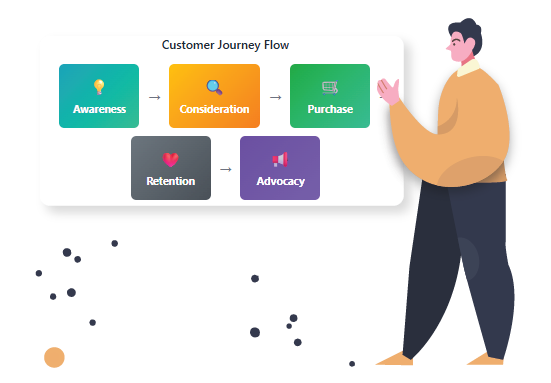Now Reading: The Fundamentals of Customer Journey Mapping
-
01
The Fundamentals of Customer Journey Mapping
The Fundamentals of Customer Journey Mapping
In today’s competitive market, understanding your customer is the key to building a successful business. A customer journey map is an invaluable tool that helps you see your product or service from your customer’s perspective. By visualizing the entire experience, from their first interaction to becoming a loyal advocate, you can uncover opportunities, identify pain points, and create a truly exceptional experience. This guide will walk you through the core concepts of journey mapping and why it is a fundamental practice for any business.
What Exactly is a Customer Journey Map?

A customer journey map is a visual representation of the process a customer goes through to achieve a goal with your company. It is not just a flowchart but a detailed story that illustrates the customer’s end-to-end experience from their unique point of view. The map typically outlines the various stages a customer navigates, such as Awareness, Consideration, Purchase, Retention, and Advocacy.
For each of these critical stages, the map documents a series of elements that reveal the customer’s state of mind and interaction with your brand. This includes their specific actions, their emotional state, their underlying needs, and any friction points they encounter. By bringing these elements to light, the map provides a holistic understanding that goes far beyond simple behavioral data.
Why is Journey Mapping Essential?
Journey mapping is more than just a visualization; it’s a strategic exercise that provides profound business value. By mapping the customer experience, you can identify hidden frustrations and friction points that may be causing customers to abandon their journey. It helps you uncover new opportunities to delight customers and exceed their expectations. Furthermore, a shared journey map provides a single source of truth for your entire organization, aligning marketing, sales, product, and support teams around a common goal: to deliver a superior customer experience.
Key Components of a Journey Map

A comprehensive journey map is built from several key components. Touch points are every interaction a customer has with your business, from seeing an ad to receiving a support email. The customer action is what the customer does at that touch point, such as clicking a link or making a purchase. The emotions and needs section captures how the customer feels and what they are trying to achieve. Pain points are moments of frustration, while opportunities are areas for improvement. Finally, assigning a responsible party ensures that every insight is linked to a team or individual accountable for addressing it.
Getting Started with Your First Map
Creating your first journey map doesn’t have to be complicated. Start by defining your project details, including your business name and industry. Next, choose a customer persona to focus on and outline their journey through the defined stages. Fill in the details for each touch point and customer action, then add the corresponding emotions and pain points. By collecting this information, you can start to identify clear opportunities for improvement and assign tasks to the relevant teams.

